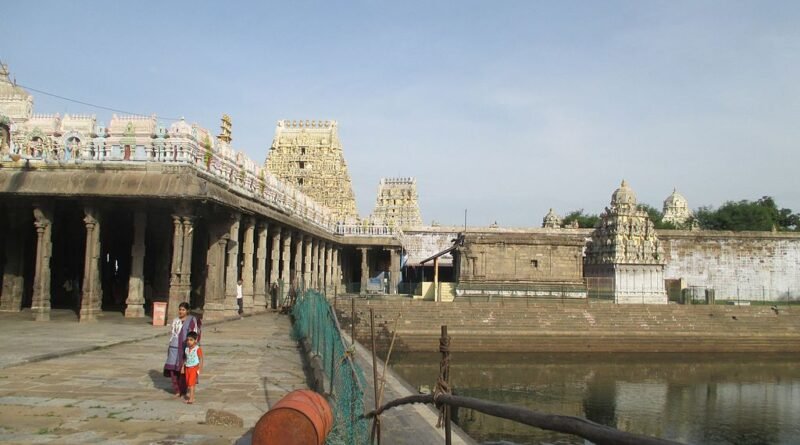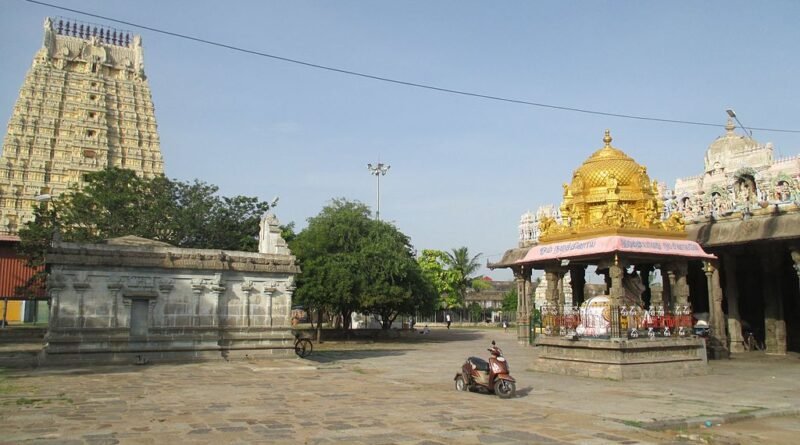Nilathingal Thundam Perumal temple
Nilthingal Thundam Perumal temple (also called Chandrasoodeswarar Perumal temple) is a Hindu temple dedicated to Vishnu, located in Kanchipuram in the state of Tamil Nadu, India. The temple is located in a shrine in Ekambareswarar Temple, the largest temple in the town of Kanchipuram, located in the northern part of the town. The temple gopuram (gateway tower) is 59 m tall, which is one of the tallest gopurams in India.
The temple is glorified in the Nalayira Divya Prabandham, the early medieval Tamil canon of the Alvar saints from the 6th–9th centuries CE. It is one of the 108 Divya Desams dedicated to Vishnu, who is worshiped as Nilathingal Thunda Perumal and his consort Lakshmi as Nilathingal Thunda Nayagi.
Six daily rituals and two major yearly festivals are held at the temple, of which the Vaikuntha Ekadashi festival, celebrated during the Tamil month of Margali (December–January), is the most prominent. The temple is maintained and administered by the Hindu Religious and Endowment Board of the Government of Tamil Nadu. Unlike other Vaishnavite temples where a Vaishnavite priest officiates, the temples has a Saiva priest as it in inside a Shiva temple.
Legend
Parvati, the consort of Shiva was doing penance under the temple’s ancient mango tree near Vegavathi river. In order to test her devotion Shiva sent fire on her. The goddess Parvati prayed to her brother, Vishnu for help. Vishnu took the crescent from Shiva’s head and reflected the rays which then cooled down the tree as well as Parvati. Shiva wanted to test Parvati again and sent the river Ganga (Ganges) to disrupt her penance. Parvati prayed to Ganga and convinced her that both of them were sisters and so she should not harm her. Subsequently, Ganga did not disturb her penance and Parvati made a Shiva Linga out of sand to get united with Shiva. Shiva came to be known as Ekambareswarar or “Lord of Mango Tree” and Vishnu as Nilathingal Thundam.As per Hindu legend, Parvati was doing penance at this place to attain the blessings of her husband Shiva. She sought the help of Vishnu to help her in the cause. Vishnu appeared as Vamana with a conch and disc and radiated light as moon. It is believed that Vishnu appeared for Chandra (moon) and Shiva.As per another legend, when devas (celestial deities) and asuras (demons) were churning the Ocean of Milk, Vishnu helped them as a tortoise Kurma holding the mount. The snake Vasuki using as a rope for churning emanated poison that turned the skin colour of the tortoise from blue to black. Vishnu reached out to Brahma for resolution, who advised him to worship Shiva. It is believed that sun and moon are the two eyes of Shiva. He opened his left moon eye to ease the pain of Vishnu with the cold lunar rays. On account of it, the presiding deity came to be known as Nilathingal Thunda Perumal.
History
The Ekambareswarar temple is one of the most ancient in India having been in existence since at least 600 CE. A 2nd-century CE Tamil poetry speaks of Kama kottam, and the Kumara kottam (currently the Kamakashi Amman temple and the Subramanya temple). Initially temple was built by Pallavas. The Vedantist Kachiyapper served as a priest at the temple. The existing structure then, was pulled down and rebuilt by the later Chola Kings. Adi Sankara, the 10th-century saint got Kanchipuram remodeled along with expansion of this temple along with Kamakshi Amman temple and Varadaraja Perumal Temple with the help of local rulers.The Vijayanagara kings, during the 15th century, also made lot of contributions to the temple and later developed by Vallal Pachiyappa Mudaliar used to go regularly from Chennai to Kanchipuram to worship in this temple, he spent significant money he amazed during British rule on the temple renovation, Pachiyappa Mudaliar seated at horse back can be seen in the temple pillar. At the later stage a similar temple with same name Ekambareswarar was constructed in Chennai by Pachiappa Mudaliar in order to avoid travelling time to Kanchipuram. The Archaeological Survey of India report of 1905–06 indicates widespread renovation activities carried out in the temple by Nattukottai Chettiar.In modern times, the temple is maintained and administered by the Hindu Religious and Endowment Board of the Government of Tamil Nadu.
















